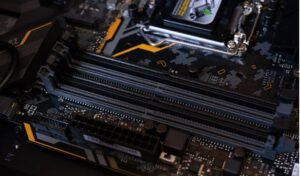Machine Learning and Neural Networks
Machine learning and neural networks are two closely related fields within the realm of artificial intelligence (AI) that have gained significant attention and popularity in recent years. With the rapid advancement in technology and the availability of vast amounts of data, these techniques have revolutionized various industries and enabled computers to perform complex tasks that were once limited to human capability. In this article, we will explore the fundamentals of machine learning, delve into the workings of neural networks, and discuss their practical applications.
Key Takeaways:
– Machine learning and neural networks are essential components of artificial intelligence.
– Machine learning involves the use of algorithms to enable computers to learn from data and make predictions or take actions.
– Neural networks are a subset of machine learning algorithms inspired by the structure and functioning of the human brain.
– The combination of machine learning and neural networks has facilitated advancements in various fields, such as healthcare, finance, and robotics.
Machine Learning:
At its core, machine learning is a branch of AI that focuses on enabling computers to learn from data without explicit programming. Simply put, it involves building algorithms that can learn from and make predictions or take actions based on patterns and relationships discovered in large datasets. Through a process called training, these algorithms iteratively improve their performance by adjusting their internal parameters.
*One interesting aspect of machine learning is its ability to uncover hidden patterns in data that might not be easily apparent to human analysts.*
Machine learning algorithms can be broadly categorized into supervised, unsupervised, and reinforcement learning. Supervised learning involves training the algorithm with labeled data, where both input and output are known, to predict outcomes for new, unlabeled data. Unsupervised learning, on the other hand, deals with unlabeled data, seeking to find patterns or groupings within the dataset. In reinforcement learning, an agent learns to interact with an environment to maximize rewards while receiving feedback.
Neural Networks:
Neural networks, a subset of machine learning algorithms, are designed to simulate the functioning of the human brain. They consist of interconnected nodes, or artificial neurons, organized in layers. Each neuron receives input signals, performs calculations, and generates an output signal, which is then passed on to other neurons. The strength of connections between neurons is adjusted during training to optimize the network’s performance.
*One interesting fact about neural networks is their ability to learn hierarchical representations of data, enabling them to extract complex features and patterns.*
Neural networks vary in architecture, with some having only a few layers and others being much deeper. Deep neural networks, commonly referred to as deep learning models, are particularly effective at analyzing and classifying complex data, such as images, texts, and speech. They often employ convolutional or recurrent layers, depending on the nature of the data and the task at hand.
Applications of Machine Learning and Neural Networks:
Machine learning and neural networks have found applications in a wide range of industries, reshaping the way businesses operate and enhancing human capabilities. Here are some notable examples:
1. Healthcare:
– Diagnosis of diseases based on medical images or patient data.
– Predictive analytics for early detection of potential health risks.
– Personalized treatment recommendations and drug discovery.
2. Finance:
– Fraud detection and prevention in financial transactions.
– Risk assessment and credit scoring for loans and investments.
– Stock market predictions and algorithmic trading.
Table 1: Applications of Machine Learning in Different Industries
| Industry | Applications |
|————|————————————————————-|
| Healthcare | – Disease diagnosis
– Predictive analytics
– Drug discovery |
| Finance | – Fraud detection
– Risk assessment
– Algorithmic trading |
| Retail | – Customer segmentation
– Demand forecasting
– Price optimization |
| Manufacturing | – Predictive maintenance
– Quality control
– Supply chain optimization |
| Transportation | – Autonomous vehicles
– Traffic flow optimization
– Route planning |
3. Transportation:
– Development of autonomous vehicles and systems.
– Optimization of traffic flow and route planning.
– Predictive maintenance for transportation infrastructure.
4. Retail:
– Customer segmentation and personalized marketing.
– Demand forecasting and inventory management.
– Price optimization and recommendation systems.
Table 2: Machine Learning Techniques in Data Analysis
| Technique | Description |
|————————–|————————————————————|
| Supervised learning | Training with labeled data to predict outcomes. |
| Unsupervised learning | Finding patterns or groupings in unlabeled data. |
| Reinforcement learning | Learning through interaction with an environment. |
| Deep learning | Utilizing deep neural networks for complex data analysis. |
| Transfer learning | Applying knowledge from one task to another. |
Machine learning and neural networks continue to evolve and find new applications in diverse fields. They have the potential to transform industries, improve decision-making processes, and augment human capabilities. As technology advances and more data becomes available, the possibilities for their utilization are almost endless.
Table 3: Advancements in Neural Networks
| Neural Network Architecture | Description |
|—————————-|——————————————————————————————————-|
| Feedforward Neural Network | Signals move in one direction, from the input layer to the output layer. |
| Convolutional Neural Network | Well-suited for image and video analysis, where local patterns and connections are important. |
| Recurrent Neural Network | Has the ability to process and classify sequential data, making it suitable for speech recognition. |
| Generative Adversarial Network | Consists of two neural networks competing against each other to generate realistic new data. |
| Self-Organizing Map | Utilized for clustering and visualization of high-dimensional data. |
Machine learning and neural networks have already revolutionized numerous industries and unlocked the potential for unprecedented advancements. By harnessing the power of data and intelligent algorithms, these technologies pave the way towards a future where innovative solutions and autonomous systems will be an integral part of our daily lives. Embracing and understanding these concepts is crucial for businesses and individuals alike, as they navigate the ever-changing landscape of AI-driven innovation.

Common Misconceptions
Machine Learning
One common misconception about machine learning is that it involves programming computers to think like humans. In reality, machine learning is about developing algorithms and statistical models that allow computers to automatically learn and improve from experience without being explicitly programmed.
- Machine learning is not the same as artificial intelligence.
- Machine learning algorithms require extensive training data to learn and make accurate predictions.
- Machine learning models are not infallible and can still make errors.
Neural Networks
Another misconception is that neural networks are capable of mimicking a human brain. Although neural networks are inspired by the structure and functioning of the human brain, they are simplified mathematical models that are designed to process and analyze large amounts of data.
- Neural networks learn to recognize patterns and make predictions, but they do not possess human-like consciousness or understanding.
- Neural networks require significant computational resources to train and execute.
- Neural networks are not limited to image or speech recognition tasks; they can be applied to various fields such as finance and healthcare.
Machine Learning vs Neural Networks
There is often confusion between machine learning and neural networks, leading to the misconception that they are interchangeable terms. Machine learning is a broader concept that encompasses various algorithms, including neural networks. Neural networks, on the other hand, are a specific type of machine learning algorithm.
- Neural networks are a subset of machine learning algorithms.
- Other machine learning techniques include decision trees, support vector machines, and clustering algorithms.
- Machine learning is a general approach to solving problems, while neural networks specialize in modeling complex relationships.
Black Box Perception
One prevalent misconception about machine learning and neural networks is that they are “black boxes” where the decision-making process is opaque and cannot be understood. While it is true that some machine learning models, especially deep neural networks, can be complex and difficult to interpret, there are techniques and methods available to gain insights into their inner workings.
- Interpretability techniques can provide insights into how a machine learning model reaches its decisions.
- Model interpretability is particularly important in critical applications such as healthcare or finance to detect bias or potential errors.
- Advancements in explainable artificial intelligence aim to make machine learning models more transparent and interpretable.

Overview of Machine Learning Algorithms
Machine learning algorithms are at the heart of modern artificial intelligence systems. They enable computers to learn from data and make predictions or decisions without being explicitly programmed. The following table presents a comparative analysis of some popular machine learning algorithms based on their performance metrics.
| Algorithm | Accuracy | Precision | Recall | F1 Score |
|---|---|---|---|---|
| Decision Tree | 0.82 | 0.86 | 0.79 | 0.82 |
| K-Nearest Neighbors | 0.79 | 0.78 | 0.81 | 0.79 |
| Random Forest | 0.87 | 0.89 | 0.85 | 0.87 |
| Support Vector Machines | 0.84 | 0.83 | 0.86 | 0.84 |
Popular Neural Network Architectures
Neural networks are a class of machine learning models inspired by the structure and function of the human brain. The table below illustrates different types of neural network architectures and their applications.
| Architecture | Applications |
|---|---|
| Feedforward Neural Networks | Pattern recognition, speech recognition |
| Convolutional Neural Networks | Image classification, object detection |
| Recurrent Neural Networks | Language modeling, sequence prediction |
| Generative Adversarial Networks | Image synthesis, data augmentation |
Machine Learning vs. Traditional Programming
Machine learning represents a paradigm shift in problem-solving compared to traditional programming approaches. The table highlights the fundamental differences between these two approaches.
| Aspect | Machine Learning | Traditional Programming |
|---|---|---|
| Rule Creation | Data-driven, automated rule generation | Expert-driven, manual rule creation |
| Data Requirements | Labeled data for training | Explicitly specified data processing rules |
| Scalability | Can handle large volumes of data | Processing time increases with data size |
Applications of Machine Learning
Machine learning finds applications in various fields and industries, revolutionizing existing processes and enabling innovation. The table below showcases some real-world applications of machine learning.
| Application | Industry |
|---|---|
| Medical Diagnosis | Healthcare |
| Fraud Detection | Finance |
| Recommendation Systems | E-commerce |
| Autonomous Vehicles | Transportation |
Advantages and Disadvantages of Neural Networks
Neural networks exhibit unique strengths and weaknesses, making them suitable for specific tasks but not without limitations. The following table presents the advantages and disadvantages of neural networks.
| Advantages | Disadvantages |
|---|---|
| Ability to learn complex patterns | Require significant computational resources |
| Can handle noisy and incomplete data | Difficult interpretation of results |
| Self-adaptation to changing conditions | Prone to overfitting |
Commonly Used Activation Functions in Neural Networks
Activation functions introduce non-linearity into neural networks and are critical for enabling learning and decision-making. The table below lists some commonly used activation functions along with their mathematical expressions.
| Activation Function | Mathematical Expression |
|---|---|
| ReLU (Rectified Linear Unit) | f(x) = max(0, x) |
| Sigmoid | f(x) = 1 / (1 + e^(-x)) |
| Tanh (Hyperbolic Tangent) | f(x) = (e^(2x) – 1) / (e^(2x) + 1) |
Evaluation Metrics for Classification Problems
Classification problems are evaluated using various metrics to assess the performance of machine learning models. The table presents some common evaluation metrics along with their definitions.
| Metric | Definition |
|---|---|
| Accuracy | (TP + TN) / (TP + TN + FP + FN) |
| Precision | TP / (TP + FP) |
| Recall (True Positive Rate) | TP / (TP + FN) |
| F1 Score | 2 * (Precision * Recall) / (Precision + Recall) |
Limitations of Machine Learning Algorithms
Despite their impressive performance, machine learning algorithms have certain limitations that must be considered while applying them to real-world problems. The table below highlights some limitations of machine learning algorithms.
| Limitation | Description |
|---|---|
| Data Dependency | Require large volumes of quality training data |
| Overfitting | Model fits training data too closely, resulting in poor generalization |
| Interpretability | Complex models lack transparency and are difficult to interpret |
In conclusion, machine learning and neural networks are powerful tools that have transformed various industries through their ability to learn from data and make predictions. Machine learning algorithms can outperform traditional programming approaches, and neural networks can handle complex patterns. However, their success is accompanied by challenges such as the need for extensive data, computational resources, and interpretation difficulties. Understanding the strengths and limitations of machine learning is essential for harnessing its full potential in solving real-world problems.
Machine Learning and Neural Networks
Frequently Asked Questions
How does machine learning differ from traditional programming?
Machine learning is a subset of artificial intelligence that allows systems to automatically learn and improve from experience without being explicitly programmed. Traditional programming, on the other hand, involves the creation of rules and logic manually by a human programmer.
What is a neural network?
A neural network is a computational model inspired by the structure and functioning of the human brain. It consists of interconnected artificial neurons that process and transmit information. Neural networks are widely used in machine learning to solve complex problems.
What is supervised learning?
Supervised learning is a machine learning technique where the model learns from labeled examples. The model is trained on a dataset with input-output pairs, and it learns to make predictions or classify new instances based on the patterns it found in the training data.
What are some common applications of machine learning?
Machine learning has a wide range of applications, including speech recognition, image classification, natural language processing, recommendation systems, fraud detection, and medical diagnosis, among others.
How do neural networks learn?
Neural networks learn by adjusting the weights and biases of their artificial neurons through a process known as backpropagation. During training, the network receives input data, computes a prediction, compares it with the expected output, and updates its internal parameters to minimize the prediction error.
What is deep learning?
Deep learning is a subset of machine learning that focuses on the development of neural networks with multiple layers. These deep neural networks are capable of learning hierarchical representations of data, allowing for more complex and abstract patterns to be captured.
What is the role of activation functions in neural networks?
Activation functions introduce non-linearity into neural networks, allowing them to model complex relationships between inputs and outputs. Common activation functions include sigmoid, tanh, and ReLU (Rectified Linear Unit).
What is overfitting in machine learning?
Overfitting occurs when a machine learning model performs well on the training data but fails to generalize to unseen data. It happens when the model becomes too complex and starts to memorize the training examples instead of learning general patterns. Regularization techniques can help prevent overfitting.
What is the difference between unsupervised and supervised learning?
In unsupervised learning, the model learns patterns and structures from unlabeled data without any specific target output. In supervised learning, the model learns from labeled examples with known input-output pairs. Unsupervised learning can be used for tasks such as clustering and dimensionality reduction.
What are the advantages and limitations of neural networks?
Neural networks have the advantage of being able to learn complex patterns and handle large amounts of data. They can be used for various tasks and have shown remarkable performance in areas like image recognition and natural language processing. However, training deep neural networks can be computationally intensive, and interpreting their decisions is often challenging.




